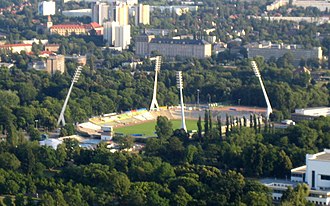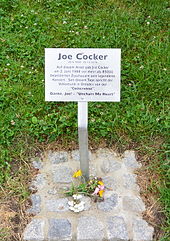Güntzwiesen

The Güntzwiesen are a green area and urban open space in Dresden . They are the location of the Dresden stadium named after Rudolf Harbig , the venue of SG Dynamo Dresden . The Güntzwiesen are named after Justus Friedrich Güntz , who set up a foundation ( Güntzstiftung ) in 1856 , which was later used to design the meadows. Its northern part has been called Cockerwiese since 2016 , after this name had already been colloquial since Joe Cocker's big concert on June 2nd, 1988.
location
The Güntzwiesen are located about one kilometer southeast of the Altmarkt and are not far from the historic core of the Saxon state capital. They still extend within the 26th ring along the west side of Lennéstrasse. The western border forms the Blüherstrasse. The Güntzwiesen belong to the southern Pirnaische Vorstadt and thus to the statistical district Seevorstadt-Ost / Großer Garten , which in turn is part of the old town district .
The Güntzwiesen is bordered by the Blüherpark and the forecourt of the Hygiene Museum in the west, the Bürgerwiese in the south , the Great Garden and the Transparent Factory in the east and the residential development of the Pirnaische Vorstadt in the north. The town hall and the former headquarters of VEB Robotron are also in the vicinity . The Güntzwiesen mark the transition from the originally densely built-up inner city to the large, central green areas of the Great Garden.
history
prehistory
The later Güntzwiesen were for centuries an undeveloped piece of land outside the gates of Dresden. After from 1676 for the elector and later elector Johann Georg III. The Great Garden had been laid out, they were in the middle between the park and the residential city. When the city began to expand in the early 19th century, the Saxon King Friedrich August I issued a construction ban in the vicinity of the Great Garden in 1826 for reasons of landscape protection, which prohibited city expansion in the south-east. Thus this area was the only one of the Dresden suburbs to remain undeveloped. Despite the lifting of the building ban in the 1860s, the immediate area around the Great Garden, including today's Güntzwiesen, could be kept free of any development until the 1880s, when it was reached by the expanding Johannstadt and the Pirnaische Vorstadt.
Construction of sports facilities
In the 19th century , the area established itself as a sports facility and thus continued to escape extensive development. As early as 1874, English people , who lived in large numbers in the so-called English Quarter in the nearby Seervorstadt , met on the lawn in front of the entrance area of the Great Garden to regularly play football under the name Dresden English Football Club . In 1883, a public exercise and gymnastics competition was held for the first time on the meadow by the Great Garden, followed by the VI in 1885 . German gymnastics festival with almost 20,000 participants. Until 1896, the city of Dresden bought other surrounding properties in order to set up a contiguous sports area. In 1896, a sports field was mentioned for the first time on the site of today's stadium, which together with seven other places formed the municipal festival area. In addition to soccer, the predominant sports at that time were gymnastics , cricket , cycling and tennis . On June 4, 1911, the final of the German soccer championship 1910/11 took place on the so-called "sports field at the hygiene exhibition " , which the Berlin TuFC Viktoria 1889 won 3-1 against VfB Leipzig . On September 10, 1911, the German national soccer team lost the 15th international match in their history against Austria in front of 7500 spectators with 1: 2.

The sports facilities were expanded in the 1920s with funds from the privy councilors and patrons Hermann Ilgen and Georg Arnhold . In May 1923 the inauguration of the Ilgen arena took place , which offered space for 24,000 spectators. Three years later, the Georg-Arnhold-Bad opened , which was called Güntzwiesenbad from 1934 to 1948. In place of the Ilgen-Kampfbahn, which was destroyed in World War II , the Rudolf Harbig Stadium was built until 1951 . Since then, the stadium has formed the southern end of Güntzwiesen - its four floodlight masts, popularly known as giraffes, were a dominant feature from 1969 to 2008. The part of the area north of the main avenue also remained undeveloped. But it was also used as a sports field. After the gardens surrounding the building had been redesigned and renamed Blüherpark in connection with the establishment of the Hygiene Museum, the neighboring meadow was also named Blüherwiese after Bernhard Blüher , Dresden's mayor from 1915 to 1931.
National Socialist Gauforen Plan
A few years later, after the seizure of power of the Nazis , the transformation of the South of Pirnaischer suburb became the new Gauforum for Saxony planned, the center would have been in the field of Güntzwiesen. The plans for this were largely drawn up by Wilhelm Kreis , the architect of the German Hygiene Museum, during the tenure of City Planning Councilor Paul Wolf , but were never implemented. In addition to the monumentality of the museum building, which was to be used for propaganda purposes, and the uniquely long lines of sight that led through the Great Garden, the decisive factor was that the land was on the one hand in the hands of the city and on the other hand was still undeveloped. Among other things, a Gauhaus, a 40,000-person hall at the site of today's stadium, a high tower, a central parade area named after Adolf Hitler ( Adolf-Hitler-Platz ) and a temple of honor were planned.
Use for large events
Even in the subsequent period of German division, the area around the eastern Lingnerallee was not built on, although an expansion of the Robotron combine headquarters was planned on these areas at times. After Western rock stars were allowed to perform in the GDR towards the end of the 1980s, Joe Cocker gave a major concert on June 2, 1988 in front of over 85,000 people on the Blüherwiese. In addition to Bruce Springsteen's appearances in Berlin at the Weißensee Radrennbahn and Bob Dylans in Treptower Park, it was one of the biggest rock concert events in the history of the GDR. Since then, the name Cockerwiese has become popular for the Blüherwiese and the city of Dresden dedicated a plaque to the musician who died in 2014 on the occasion of his 71st birthday in May 2015. Since a city council resolution in January 2016, the meadow officially bears this name. During the fall of the Wall, Heinz Rudolf Kunze and Herbert Grönemeyer gave further major concerts at this point . On October 26, 1989, 100,000 people took part in a demonstration on the Cockerwiese and sought dialogue with those responsible in the city.
In 1999 the 1st German Theater Fair took place on the Cockerwiese. Between May 2004 and February 2008, the Sea Life Center , one of the world's largest mobile seawater aquariums, was also located here . The complex was previously in Dortmund and then moved on to Cuxhaven . Every Friday there is a weekly market on Lingnerallee. Large events are still occasionally held on the Cockerwiese today. To this end, large interim buildings have already been built several times for conferences, for example in December 2007 for a Volkswagen management conference .
On January 5th, 2015, the weekly PEGIDA demonstration in Dresden took place on the Cockerwiese.
Planning of a new school location and residential area
On June 19, 2019, the Committee for Urban Development, Building, Transport and Real Estate decided to draw up a development plan for the Cockerwiese. According to this, the area is to be used for the construction of a primary school, a high school and a gymnasium as well as for the construction of residential buildings in the eastern area.
Individual evidence
- ↑ Thomas Kantschew: Further growth of the city. In: The urban development of Dresden in the 19th century - from the demolition to the early days. January 19, 1996, accessed on June 17, 2015 (term paper as part of the master’s examination at the Department of History at the Free University of Berlin).
- ↑ The history of the stadium at the Great Garden. In: dynamostadion.de. December 2010, accessed June 17, 2015 .
- ↑ Bürgerwiese, Blüherpark, Güntzwiesen. In: dresden-und-sachsen.de. Retrieved June 17, 2015 .
- ↑ HSchulze: Stadium history. May 23, 2006, accessed on June 17, 2015 ( BBS -Posting).
- ↑ The planned "Gauforum Dresden": Tool for mass manipulation - gigantomania of German fascism. In: das-neue-dresden.de. Retrieved June 17, 2015 .
- ↑ Robotrongelände Dresden: nucleus of microelectronics for Silicon Saxony. In: das-neue-dresden.de. Retrieved June 17, 2015 .
- ^ Culture in the GDR: Exodus and cultural ice age ( Memento from April 23, 2006 in the Internet Archive )
- ↑ Memorial plaque for Joe Cocker in memory of his legendary concert in Dresden in 1988. State capital Dresden, May 20, 2015, accessed on December 25, 2016 (press release).
- ↑ Cockerwiese can now also be officially called Cockerwiese. In: Sächsische Zeitung online. January 21, 2016, accessed February 6, 2016 .
- ↑ On a knife's edge: The Long Night about the fateful days in Dresden and Leipzig '89. DeutschlandRadio , October 2, 1999, accessed June 17, 2015 .
- ^ The group of 20 in Dresden - demonstrations and rallies in Dresden. In: ddr89.de. Retrieved June 17, 2015 .
- ^ The 1st German Theater Fair in Dresden from 23-25. April 1999 (DeutschlandRadio FAZIT). In: balticulture.de. Retrieved June 17, 2015 .
- ↑ Matthias Meisner : Demonstrations by opponents of Islam in Dresden: Even the CDU in Saxony has enough with “Pegida”. In: Der Tagesspiegel . January 6, 2015, accessed June 17, 2015 .
- ↑ Dirk Hilbert: Development plan no. 389 C Dresden-Altstadt II no. 27 City quarter at Blüherpark-Ost. City of Dresden, October 9, 2019, accessed on November 15, 2019 .
Web links
- History of the Harbigstadion 2
- Nazi plans for the Gauforum
- Photo of the ball thrower statue at the old location
Coordinates: 51 ° 2 ′ 37 " N , 13 ° 44 ′ 58" E

